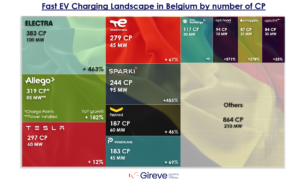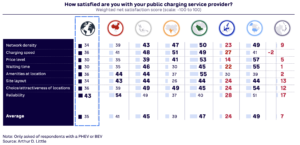For this episode, we interviewed Eric van Voorden. He is the founder and CEO of Last Mile Solutions (2007) and the Chairman of the Dutch Organization of Electrical Transport (DOET).
You are the co-founder of one of Europe’s oldest EV Charging companies. How did you start your career in e-Mobility?
After developing different kinds of SAAS platforms for the telecom industry, DRIP’s (Dynamic Route Information Panels) and track and trace systems for leisure vessels in the early 2000’s, in 2007 I came in contact with Eneco. This energy utility was looking for a partner to build a platform to manage charging stations, as well as to help develop those stations.
Seeing that both my business partner, Johan Brouwer, and I have a background in the development of both SAAS platforms and electronics, we took up the assignments.
Many similar projects followed and we started to expand our platform to a white label format. In 2008 it took on the form of what it is now: Last Mile Solutions.
Looking back, what challenges did you face the first years to build a successful e-Mobility ecosystem along with all parties involved?
There were several challenges. In the beginning there was no charging eco-system basis to work from, so we were inventing the wheel over and over again.
For example, the first charging station we developed for Eneco had to be approved by Kema, and they had never done this before. There were no electric vehicles to test the station with, so it was really a time of pioneering work.
Back then, there was also no standardized way of cooperating with other charging providers. Early on we founded an organization, eViolin, so we could make our charging stations compatible with different platforms.
Another challenge was to earn credibility in the market. But because we entered the market so early and talked with many other parties about the way forward, we were taken seriously quite quickly.
Now this is all commonplace, but in those first years we literally had to invent all of it. No more than a few years ago we still had to convince more conservative minded parties that electric transportation is the future. You could say that ‘missionary’ work is now indefinitely behind us.
From the start, you successfully worked along with your co-founder Johan Brouwer (currently still CTO). What are the key success factors for this ‘15-year old EV marriage’?
Johan and I have known each other since college. At Hogeschool Rotterdam we clicked right away and from that moment on worked together on many different projects, leading up to the founding of Last Mile Solutions in 2008. We’re both technicians, but Johan stayed on the developing side of electronics and software, whereas I moved towards the commercial and operational side of the business.
The key to our successful collaboration over all these years is our complementarity. Johan loves to lose himself in the technical side of things, whereas I like to go out into the world to find inspiration and meet with clients. From our respective roles we are able to productize our skills and experiences.
LMS is currently operating its Charging Software Platform across 22 European regions. What are the ingredients to successfully scale on a European level for e-Mobility providers?
Technically our platform is EU-compatible, meaning we can roll it out in any country in Europe. The challenge lies in scaling up. We are now hovering somewhere between a scale-up and a corporate organization, looking at everything with a fresh perspective, but ensuring we have the people who can handle the commercial side of business and facilitate the onboarding of new clients on our platform.
We are in the process of expanding our support division and will work with hubs in all countries we are active in to make sure we have local representation. Through my travelling, I have learned that in order to establish your business in another country, it is important to be in contact with the local culture.
At present, we are in the process of scaling and professionalizing our business by; hiring more talented people, continue building our European network and to further adapt our product portfolio to regional markets and industries.
The European EV Market will grow from 580.000 to 1.2 million plug-is. Is the EV Charging Market capable of catching up with this massive growth for the years to come?
The rapid growth of the EV market is both an opportunity as a challenge. The challenge is to make sure the charging market is able to keep up pace. Luckily, we can rely on our previous scale-up experiences in more mature EV markets like The Netherlands.
Because of the pioneering work we did years ago, we now know how to scale in an efficient and affordable way. We will use this experience to facilitate the growth of other European markets.
For example, we are scaling our customer service organization in such a way to make sure local charging providers can act quickly when local demand rises.
There are quite some rumours about price transparency for charging. What is your opinion about this matter and how can this be solved on a European level?
For our company, price transparency is an absolute priority. The end user should be able to have insight in the costs of charging in a clear and understandable way. As a member of the ‘eViolin committee’ we are dealing with this issue for a long time to get clarity on the subject.
By means of the ACM, the government issued an ultimatum for the charging market to be completely price transparent. We took the lead by adjusting our system in such a way that the end user always knows the price of charging, even when we don’t know the exact price of the operator.
Last Mile Solutions is currently capable of supporting all Euro currency driven countries in the EU. In the future this price transparency solutions will also apply to other currencies.
What was the most memorable moment in your e-Mobility career so far?
One of those memorable moments for us was when we won the tender for the taxi hall at Schiphol back in 2015. A total of 100 Tesla’s had to be charged at the same time, meaning we had to come up with a smart charging concept where all the technology was integrated in the charging stations themselves.
To lower the investments needed, we created a solution to facilitate large-scale charging of vehicles without building additional hardware. By that time, a huge differentiator compared to the more conventional offerings from other providers.
A huge reward for our IT and engineering teams and this win further increased our credibility as an expert in this EV Charging field. More important, this encouraged the whole team to push on to the next level for the years to come.
Looking back, this moment in time was an important building block to establish our company, creating today’s foundation for further growth across Europe.



